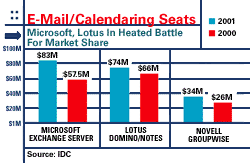Lotus Follows Up
Perhaps more important, Lotus, part of IBM's Software Group, intends to make good on its promise to offer J2EE support with the new Domino 6 by bundling IBM's WebSphere Application Server for free.
Solution providers were glad to hear that Lotus will be supplying J2EE support in a way that doesn't require them to buy additional software.
"This is an incredibly smart thing to do. Lotus' multiple-lane highway scenario says, 'Use Domino today, blend WebSphere when you're ready.' What better way than to provide the WebSphere?" said David Via, vice president of business development at the Wolcott Group, Fairlawn, Ohio.

WebSphere is typically fairly pricey. IBM charges $8,000 per processor for the single-server version and $12,000 per processor for multiserver use.
There are some limitations to WebSphere's use in the bundle. For one, it must be used in conjunction with Domino applications, not as a stand-alone, and it must be installed on the same physical server as Domino, Lotus said.
WebSphere can be used to access Domino objects and data but cannot use WebSphere Java Connector Architecture (JCA) connectors or Enterprise JavaBeans (EJBs), according to Lotus. In effect, Lotus is requiring Domino, not WebSphere, to be at the core of the information exchange for the application to legally use the WebSphere Java support.
Lotus was working on its own J2EE support for Domino with software, code-named Garnet, but pulled it last January, causing a minor furor at Lotusphere. At the time, Lotus said the project was killed because the J2EE support was nonstandard.

\
Lotus' Zollar is slated to debut Sametime 3.0 and QuickPlace 3.0 this week.
"This is not much different from the direction we were going with embedded J2EE servers, but instead of a crippled implementation, we'll have a full-function J2EE server with WebSphere," said Ken Bisconti, vice president of messaging services at Lotus. "The added benefit is we're giving it to customers as a way to get started."
Among Lotus' biggest challenges will be to bring Domino developers into the J2EE/Web services world without sacrificing their skill set, and to acquaint Java developers with the niceties of collaborative development using Domino, Bisconti said.
"There are two developer kits. One is Domino-centric but moving toward J2EE. The other is pure J2EE. We have to move these guys together," Bisconti said. "There's a whole WebSphere contingent who know J2EE apps but don't know collaborative services."
Lotus Domino is locked in a heated battle for market share with Microsoft Exchange on the mail and collaboration front. Microsoft next week is slated to offer more details of the upcoming interim release of Exchange, code-named Titanium.
In addition, Lotus will move Domino from its current per-server price model to a per-CPU scheme that better fits into IBM Software's overall price structure, Bisconti said.
The current Domino release comes as a plain mail server supporting one to four CPUs for $894 per server. The full Domino application server, supporting the same range of CPUs, is $2,300 per server. The full-blown advanced server, which supports nine or more CPUs, costs about $25,000. "We'll be collapsing all this down to a much simpler CPU-based model," he said.
As first reported in CRN, Lotus General Manager Al Zollar this week plans to show off Sametime 3.0 and QuickPlace 3.0. The new Sametime secure instant messaging product offers better video support, including 360-degree camera views of online meetings, and better interoperability with AOL Instant Messenger. QuickPlace 3.0 has streamlined caching and better page rendering performance, according to Lotus documents.